1955 Belgian Grand Prix race report: Silver Arrows dominate
Mercedes pair of Juan Manuel Fangio and Stirling Moss cruise to a 1-2 finish

Mercedes' Juan Manuel Fangio on his way to victory
Motorsport Images
The Royal Automobile Club of Belgium, who organise the Grand Prix on the hilly and wooded Spa-Francorchamps circuit, invariably prefer a small entry of top drivers to a large entry of assorted talent, and this year was no exception. Of the 15 entries only two were private owners, the rest being factory runners, while unlike many meetings race day was confined solely to the Belgian Grand Prix, which counted points for the World Championship.
Since last year some improvements had been made to the circuit, notably the complete resurfacing of the long, and previously bumpy, Stavelot curve, the wide tarmac road having a 12-in, edging of concrete flush with the road circuit. Thursday evening saw the first practice period take place and Mercédès-Benz and Ferrari were out in full force, the Stuttgart firm having three different cars, while the Italians had three Tipo 555 cars and one spare car of the older type, the 625 model.
The Mercédès-Benz team consisted of a medium-length wheelbase car, with outboard front brakes, to be driven by Fangio, a similar length car with inboard brakes, for Moss, and a long-chassis car as the training-car which Kling, Uhlenhaut and the other two drivers all shared.
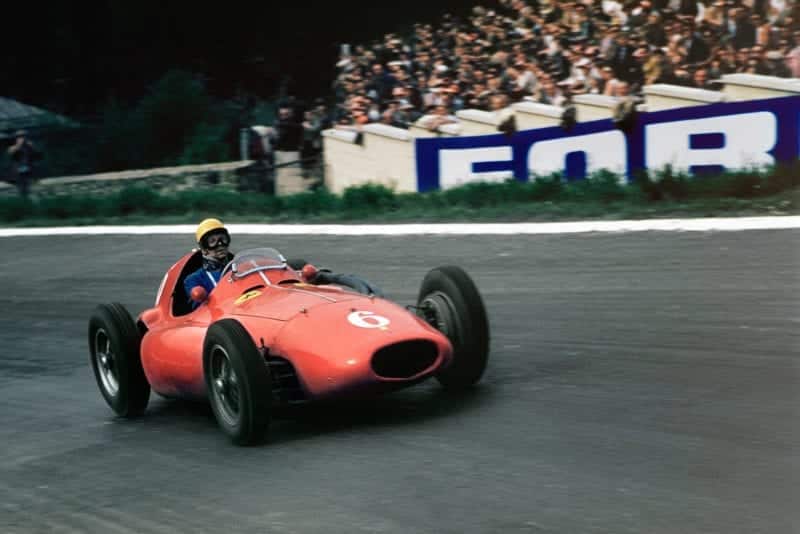
Paul Frère qualified 4th
Motorsport Images
The Ferrari team were in the unusual position of having three entries, four drivers and five cars, Farina and Frère were indeed definite starters, while the third place lay between Trintignant, not fully recovered from his accident at Monza the previous week, and Schell, the practice times of these two deciding who would start. In spite of bruises and a stiff leg Trintignant was the faster, and Schell was retained as spare driver.
After the tragic loss of Ascari, the Lancia team were in an unhappy position and though they had two entries for the race, only Castellotti turned out, he having two cars to use in practice and choose the best. There never has been a surfeit of good Grand Prix drivers, but usually there were enough to go round, but nowadays the shortage is becoming acute and even the best cars have to stand idle at times. No Maseratis arrived in time for the first practice evening, and the list was completed by Hawthorn with the Vanwall.
Qualifying
From the start Fangio set the pace and the three Mercédès-Benz drivers and the engineer rang the changes on the different models throughout the evening, finally deciding that the car they had brought along as spare was actually the best suited to the circuit, all of them preferring the handling of the long-chassis car. Not having been to the Spa circuit since 1939 the team were finding out what the requirements were by hit-or-miss methods.
The existing lap record for this high-speed circuit stood to Fangio with an Alfa-Romeo in 4min 22.1sec and Fangio had little difficulty in improving on this with the 2 ½-litre Mercédès-Benz, finally getting down to 4min 18.7sec, a speed of 196.490kph. Moss achieved 4min 24.4sec and the only other driver to approach these two was Farina who did 4min 27.1sec with the new Ferrari, these cars now having long protruding nose cowlings with a very small air-entry. Castellotti was feeling his way round the circuit for the first time, for the Belgian circuit is one full of very fast curves, the downhill ones being extremely difficult to take on the limit. Hawthorn was beginning to go well with the Vanwall when a pigeon got in his way and was scooped up into the radiator, fortunately without doing any serious damage, but shortly after that the water header-tank split and put a finish to his practice.
“Very soon it was clear that Castellotti had really learnt his way round the circuit and the Lancia times began to diminish rapidly”
This first period was more a question of suiting the car to the circuit than serious starting-grid times, but on Friday evening things were different. With the exception of Claes, who was to drive Moss’ Maserati, the whole entry was out for practice and things began to hum a little. Fangio now had a normal long-chassis Mercédès-Benz, Kling a similar car, and Moss the medium-length car with inboard brakes, and once more the German team began to set the pace, but very soon it was clear that Castellotti had really learnt his way round the circuit and the Lancia times began to diminish rapidly.
Farina was also getting back into his real stride and was making the 555 Ferrari go as never before, while Behra and Musso were leading the Maserati attack very effectively. Using first one of the Lancias and then the other, Castellotti did very nearly a whole Grand Prix race during the evening, getting progressively faster and faster and finally recording 4min 18.1sec. This caused a stir in the German camp, for earlier Fangio had done 4min 18.6sec, and Moss had done 4min 19.2sec and they were resting content at that.
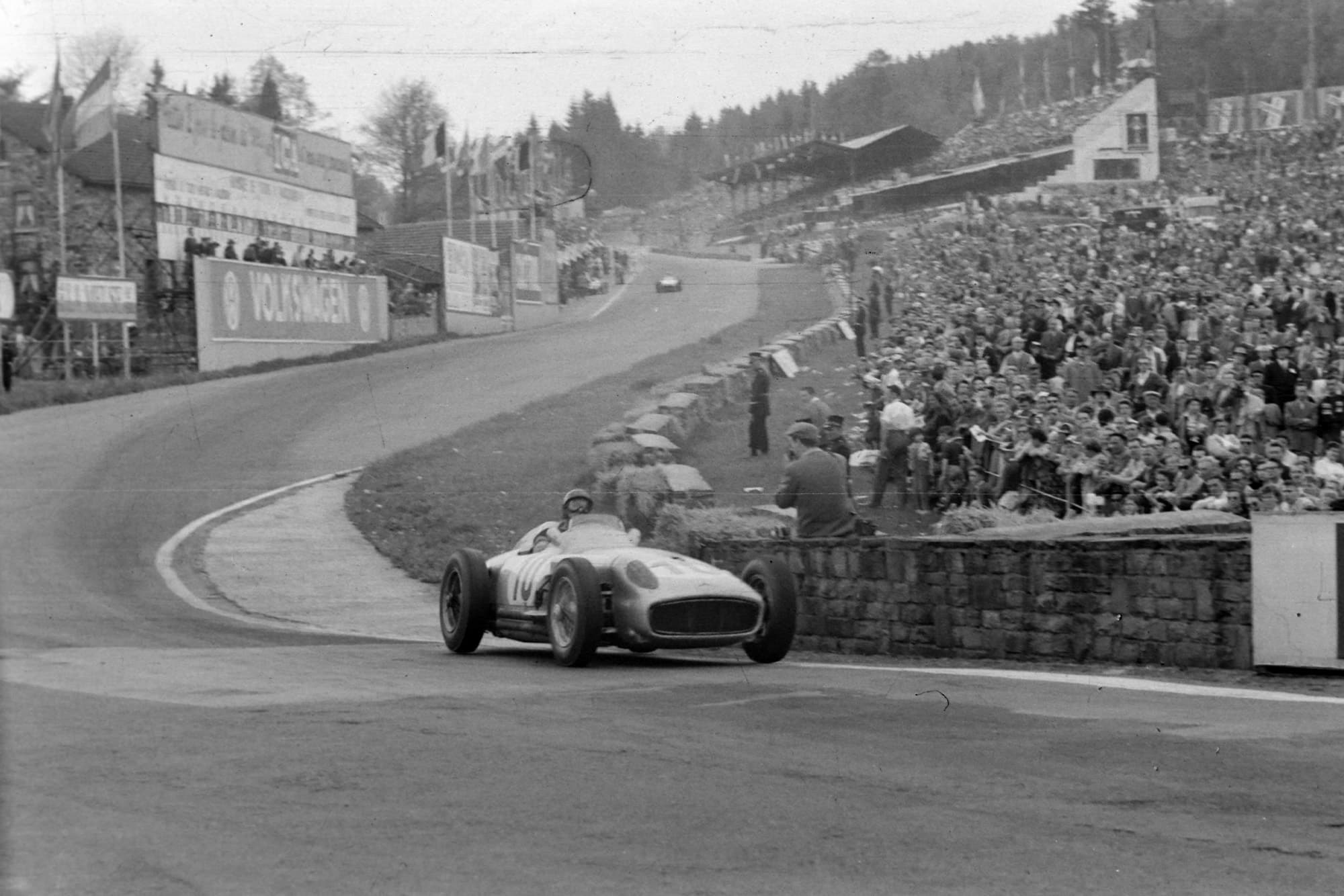
It was now too late for them to have another go, so practice finished with Castellotti on top. Farina had got down to 4 min 20.9 sec and these four were way ahead of all the other drivers, the circuit showing where the real differences between car/driver combinations lay. Behra was not really at home on such a fast circuit, neither was Musso, while poor Mieres fell off a pit counter and twisted his ankle before he really got going at all. The new driver Perdisa, who had shone so well round the houses at Monte Carlo, was quietly finding out what real Grand Prix racing was all about and keeping company with Rosier at the end of the list of times.
The Vanwall was in trouble again, this time with its gear-selecting mechanism, but before this happened Hawthorn had got down to 4 min 33 sec. Having a car to spare, the Mercédès-Benz team were using it for endurance testing and it was circulating continuously driven by the various team drivers, and in addition John Fitch was given the opportunity to drive it for a lap or two.
These two practice periods had been held under perfect summer conditions and the Saturday afternoon practice was looked forward to with great excitement, for it was expected that Moss and Fangio would try to deal with the time of Castellotti. However, it was not to be, for Saturday was a day of continual rain and there was no hope of anyone improving on their previous times. The practice Mercédès-Benz was still thrashed round by all the team drivers and Uhlenhaut, while on their own cars Moss and Fangio soon proved to be the fastest, until once more Castellotti got into his stride and put in a time between the two Mercédès-Benz.
“Before practice the Vanwall’s owner had been driving it round the town of Spa and by the time Hawthorn got it to start serious practice the clutch had fallen apart”
The respective times of Fangio, Castellotti and Moss were, 4 min 53.1 sec, 4 min 53.4 sec and 4 min 55.2 sec, with Kling next best in 4 min 57.3 sec and these were the only ones to get under 5 minutes in the pouring rain, which was some achievement, though Frère did an excellent 5 min 02.1 sec and Behra 5 min 02.9 sec. Farina made no attempt to go fast, doing only a few laps just to get the feel of the course in rain, while the Vanwall was still in trouble. Before practice the Vanwall’s owner had been driving it round the town of Spa and by the time Hawthorn got it to start serious practice the clutch had fallen apart. By Saturday evening everyone was very wet and gloomy and prospects for the race did not seem too good, but, as so often happens in Spa, race day was dry and warm, with some cloud keeping off the intense heat of the sun, so that conditions were pretty well perfect.
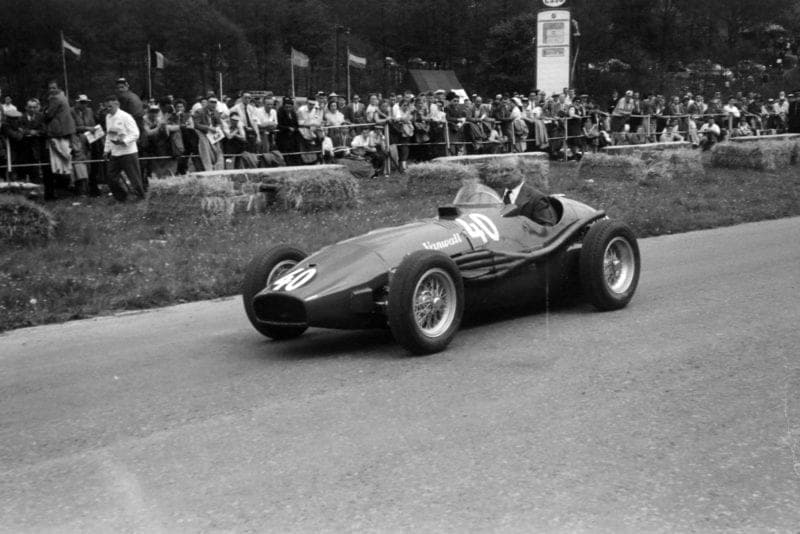
Tony Vandervell tries Mike Hawthorn’s Vanwall
Motorsport Images
As the cars were placed on the downhill starting grid, it was the lone Lancia that had the pole position on the left of the front row, with Fangio and Moss alongside. Behind were Farina and Behra, then came Kling, Musso and Frère, followed by Hawthorn and Trintignant and in the back row, Perdisa, Rosier and Mieres, the last named driving in spite of his twisted ankle. Claes was a nonstarter as he broke the engine of the green Maserati while he was supposed to have been running-in some new bearings before the final practice.
Race
As the flag was raised mechanics were still trying to push-start Musso’s Maserati but it was proving obstinate and as everyone began to creep forward he was wheeled to the back of the grid. The flag went down and in a cloud of dust and smoke the 13 cars shot down towards the river bridge before the climbing turn up into the Burnenville Forest. Fangio neatly flicked his car sideways as he went into the left-hand corner over the bridge, thus effectively stopping Castellotti cutting through on the inside and the order going up the hill was Fangio, Castellotti, Moss and Kling, the German driver having made a terrific getaway.
Moss nipped past the Lancia before the end of the first kilometre and the two Mercédès-Benz set off on what was soon to prove to be a mere demonstration run. Around the 14.12 kilometres of the opening lap the old man of the Argentine really pressed on and Moss found there were places where Fangio went through on full throttle but he had to ease off just a little, and the result was that at the end of the lap Fangio was leading by nearly 3 sec.
“For fourth place, a fierce battle began to develop between Kling, Behra, Farina and Frère”
Castellotti just could not cope with this sort of driving, for doing a quick practice lap with a few gallons of fuel on board was very different from driving with full tanks, but nevertheless he was leading Kling and all the Maseratis and Ferraris quite comfortably. For fourth place a fierce battle began to develop between Kling, Behra, Farina and Frère, but the Italian Ferrari driver was really on form and he soon got away from the others and began to close up on Castellotti.
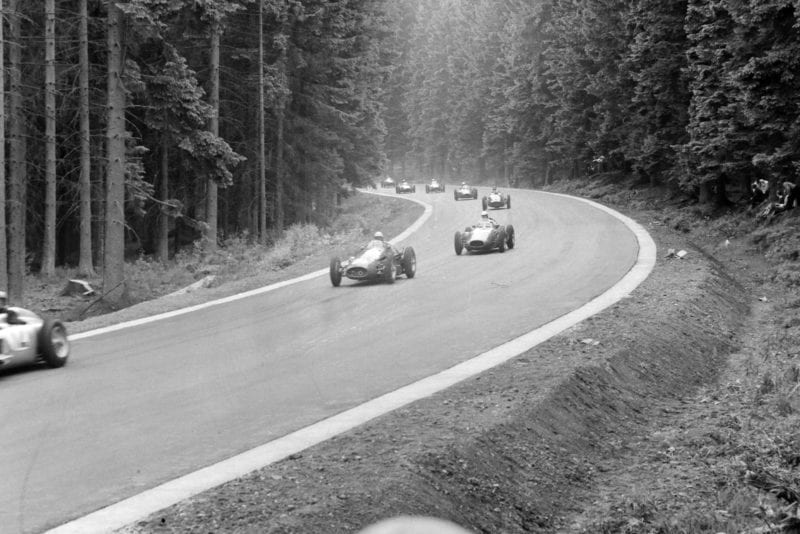
Jean Behra heads the midfield
Motorsport Images
After three laps Hawthorn was just holding on to the leading group, being in ninth place, while Mieres, Perdisa and Rosier were already well behind and Trintignant stopped at his pit to replace a plug that had literally split in two. Fangio was now nearly 6 sec ahead of his team-mate and driving hard, while Moss was leading Castellotti by a comfortable 20 sec and Farina was in the Lancia’s slipstream.
Going into the left-hand curve before the final hairpin at the end of lap four Behra lost his Maserati and it spun round, bounced from one bank to the other and stopped in the right-hand ditch, very battered and bent, but with no damage at all to the driver. He quickly walked down to the pits, and the next time round Mieres stopped and handed his car over to his team-leader, who rejoined the race in ninth place, a long way behind the leaders.
The two Mercédès-Benz went on in the lead, the gap between them growing each lap, but equally the gap between Moss and Castellotti also growing steadily. On lap nine the Vanwall began to blow oil out of its gearbox and Hawthorn stopped at the pits and withdrew, while Kling, Musso and Frère were battling furiously for fifth place, Trintignant following just behind, though a lap in arrears. At 12 laps, or a third of the total distance, Fangio had settled down 11 sec in front of Moss, and Castellotti was still third, 31 sec behind, having fended off the attack by Farina, who was now a little way back, but firmly in fourth place.
Frère had eased off a little, but Musso and Kling were fighting hard continually changing positions. Behra had obviously been somewhat shaken by his high-speed spin and was making very little headway in his second Maserati, being nearly a lap behind the leaders, while Trintignant, Perdisa and Rosier had already been lapped. On lap 15 Fangio was 14sec in front of Moss and he set up a new lap record in 4min 20.8sec, though his young team-mate was lapping only fractionally slower, for the gap between them did not vary by more than a second, and with the exception of the duel between Musso and Kling the race had become a high-speed procession.
On the next lap Castellotti failed to appear and he was reported having stopped at Malmedy corner in trouble. As though to consolidate his position once and for all, Fangio set up another new lap record just two-tenths of a second quicker than his previous one, at a speed of 195.057kph (121 mph), and still Moss was only 13 sec behind. With Castellotti out, Farina now took third place, but nearly a minute behind Moss, and the duel between Musso and Kling was now for fourth place, while Frère had dropped back and was settled in sixth position, still on the same lap as Fangio, whereas Behra was lapped by the two Mercédès-Benz cars shortly after this. At 20 laps Fangio began to ease and Moss closed up to within 5 sec and, barring mechanical trouble, they had merely to tour round and win, for Farina was too far away to be a menace.
The Musso/Kling battle ended in them both overstressing their engines and the Maserati went woolly, which a change of plugs did not cure, and the Mercédès-Benz developed an oil leak and was withdrawn. The race as such was now over, and it was just a matter of watching some very good drivers show just how to take fast corners in a modern Grand Prix car. At lap 28 both the Mercédès-Benz and the Ferrari pits signalled their drivers to ease right up and tour in to finish, and the order was Fangio, Moss, Farina and Frère, these four all being on the same lap, while behind came Behra, Musso, Trintignant and Perdisa with Rosier bringing up the rear. Although by Grand Prix standards the leading four cars were touring they were still lapping in under 4min 30sec (over 116mph).
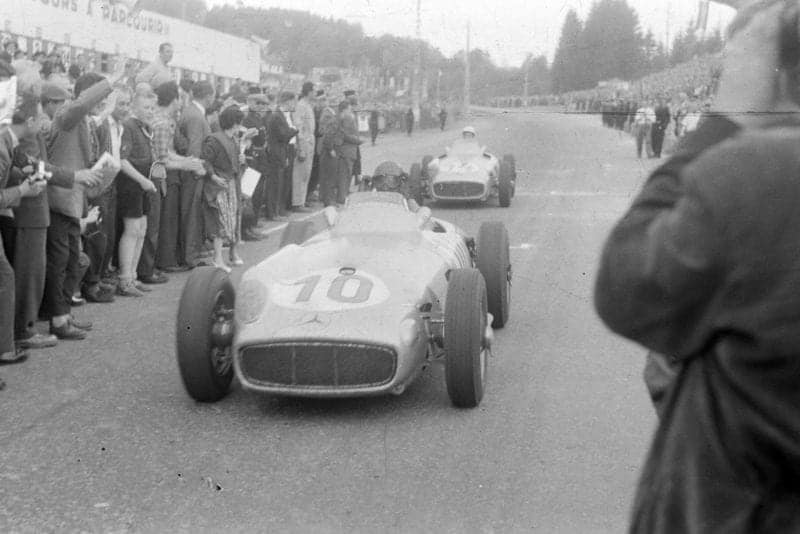
Fangio takes the plaudits after winning
Motorsport Images
So the final laps were covered and Mercédès-Benz made up for their Monte Carlo fiasco with a convincing victory, while Ferrari was greatly encouraged by having three cars start and three cars finish. The Maserati team just did not seem at home on such a fast circuit, in spite of their cars being fast, while Perdisa probably went away deep in thought after the praise that was bestowed on him after Monte Carlo. While Fangio, Moss and Farina received the applause they rightly deserved, it was Paul Frère, the Belgian driver, who was the “man of the day,” having driven a very fine race in the new Ferrari, only his second outing with the car and the first time on a real Grand Prix circuit.
1955 Belgian Grand Prix Race Results
1. Juan Manuel Fangio (Mercedes) 2:39:29.0
2. Stirling Moss (Mercedes) + 8.1
3. Guiseppe Farina (Ferrari) + 1:40.5
4. Paul Frere (Ferrari) + 3:25.5
5. Roberto Mieres/Jean Behra (Maserati) + 1 lap
6. Maurice Trintignant (Ferrari) + 1 lap
7. Luigi Musso (Maserati) + 2 laps
8. Cesare Perdisa (Maserati) + 3 laps
9. Louis Rosier (Maserati) + 3 laps
10. Karl Kling (Mercedes) Retired – Oil leak
11. Eugenio Castellotti (Lancia) Retired – Gearbox
12. Mike Hawthorn (Vanwall) Retired – Gearbox
13. Jean Behra (Maserati) Retired – Spun off
14. Johnny Claes (Maserati) Retired – Engine
15. Piero Taruffi (Ferrari) Did not start
16. Harry Schell (Ferrari) Did not start
Championship Results
1. Juan Manuel Fangio – 19
2. Maurice Trintignant – 11 1/3
3. Guiseppe Farina – 10 1/3
4. Bob Sweikert – 8
5. Stirling Moss – 7
